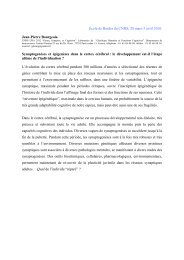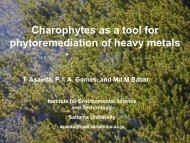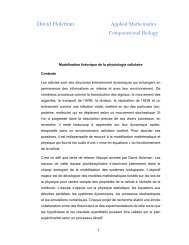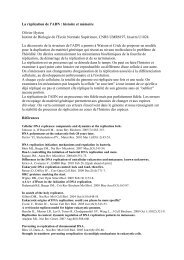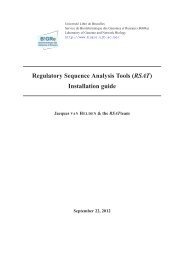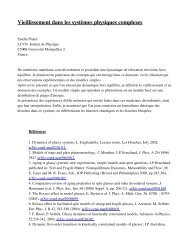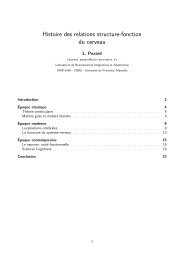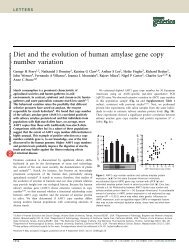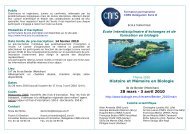PDF (2 Mo) - ENS Biology Department - Ecole Normale Supérieure
PDF (2 Mo) - ENS Biology Department - Ecole Normale Supérieure
PDF (2 Mo) - ENS Biology Department - Ecole Normale Supérieure
- No tags were found...
Create successful ePaper yourself
Turn your PDF publications into a flip-book with our unique Google optimized e-Paper software.
RESEARCH ARTICLE215Development 139, 215-224 (2012) doi:10.1242/dev.063875© 2012. Published by The Company of Biologists LtdEngrailed homeoprotein recruits the adenosine A1 receptorto potentiate ephrin A5 function in retinal growth conesOlivier Stettler 1,2 , Rajiv L. Joshi 1,3 , Andrea Wizenmann 4 , Jürgen Reingruber 3,5 , David Holcman 3,5 ,Colette Bouillot 1,3 , François Castagner 1,3 , Alain Prochiantz 1,3,6, * and Kenneth L. <strong>Mo</strong>ya 1,3, *SUMMARYEngrailed 1 and engrailed 2 homeoprotein transcription factors (collectively Engrailed) display graded expression in the chickoptic tectum where they participate in retino-tectal patterning. In vitro, extracellular Engrailed guides retinal ganglion cell (RGC)axons and synergises with ephrin A5 to provoke the collapse of temporal growth cones. In vivo disruption of endogenousextracellular Engrailed leads to misrouting of RGC axons. Here we characterise the signalling pathway of extracellular Engrailed.Our results show that Engrailed/ephrin A5 synergy in growth cone collapse involves adenosine A1 receptor activation afterEngrailed-dependent ATP synthesis, followed by ATP secretion and hydrolysis to adenosine. This is, to our knowledge, the firstevidence for a role of the adenosine A1 receptor in axon guidance. Based on these results, together with higher expression of theadenosine A1 receptor in temporal than nasal growth cones, we propose a computational model that illustrates how theinteraction between Engrailed, ephrin A5 and adenosine could increase the precision of the retinal projection map.KEY WORDS: ATP, Engrailed, Ephrin, Adenosine, Axon guidance, Homeoprotein, Chick, <strong>Mo</strong>useINTRODUCTIONInformation processing in the brain depends on precise neuronalconnections established during development and involves axonguidance molecules that repel advancing growth cones frominappropriate areas and/or attract growth cones to appropriatetarget areas (Flanagan, 2006; Scicolone et al., 2009). In theprimary visual projection, retinal ganglion cell (RGC) axonsfrom the nasal retina project to the posterior optic tectum andaxons from the temporal retina project to the anterior tectum sothat the temporal-nasal (T-N) axis of the retina maps along theanterior-posterior (A-P) axis of the tectum/superior colliculus.The low-to-high A-P repulsion of axons from temporal retina isdue, in part, to EphA forward signalling controlled by adiminishing T-N gradient of EphA receptors on RGC axons andan increasing gradient of Ephrin-As in the tectum (Flanagan,2006; Scicolone et al., 2009).Engrailed 1 and engrailed 2 (collectively Engrailed, or En)homeodomain transcription factors regulate Ephrin expression ina cell-autonomous manner in the chick optic tectum (Logan etal., 1996). However, Engrailed, as with many homeoproteins,transfers between cells and has non-cell-autonomous activitiesin gene transcription and protein translation (Brunet et al., 2007;Joliot and Prochiantz, 2004; Prochiantz and Joliot, 2003). In1 CNRS Unité mixte de Recherche 7241/INSERM U1050. Equipe FRM, Center forInterdisciplinary Research in <strong>Biology</strong> (CIRB), Collège de France, 11, place MarcelinBerthelot, 75005 Paris, France. 2 CNRS Unité mixte de Recherche 8192, Laboratoirede dynamique membranaire et maladies Neurologiques, Université Paris Descartes,Sorbonne Paris Cité, 45 rue des St-Pères, 75005 Paris, France. 3 Labex Memolife,Paris Sciences Lettres Research University, <strong>Ecole</strong> <strong>Normale</strong> Supérieure, 45 rue d’Ulm,75005 Paris, France. 4 Institute of Anatomy, University of Tübingen, Österbergstrasse3, 72074 Tübingen, Germany. 5 Institut de Biologie, <strong>Ecole</strong> <strong>Normale</strong> Supérieure(CNRS/INSERM), 46 rue d’Ulm, 75005 Paris, France. 6 <strong>Ecole</strong> Doctorale 158, UniversityPierre et Marie Curie, Bâtiment B, 7ème étage Case 25, 9 Quai Saint Bernard, 75007Paris, France.*Authors for correspondence (alain.prochiantz@college-defrance.fr;ken.moya@college-de-france.fr)Accepted 27 October 2011vitro, exogenous Engrailed attracts RGC axons from nasalXenopus retina and repels axons from RGCs in temporal retina(Brunet et al., 2005). The guidance activity of Engrailed inXenopus RGC growth cones requires the internalisation of theprotein and is blocked by inhibitors of protein translation (Brunetet al., 2005). Furthermore, Engrailed exerts guidance activitywhen the growth cone is isolated from the soma, indicating thatit acts locally. In the chick optic tectum, extracellular Engrailedis present in a low-to-high A-P gradient in the tectum andblocking extracellular Engrailed in this region leads tomisrouting of RGC axons (Wizenmann et al., 2009). In chickretinal explants, exogenous Engrailed sensitizes the growthcones of axons of temporal RGCs to ephrin A5 collapsingactivity through a mechanism that requires Engrailed-dependentprotein translation (Wizenmann et al., 2009).Here, we characterise the molecular mechanism by whichexogenous Engrailed potentiates ephrin A5-induced growth conecollapse. We find that Engrailed stimulates rapid ATP synthesis andsecretion from growth cones. Inhibiting extracellular ATPhydrolysis blocks the Engrailed/Ephrin synergy in growth conecollapse, whereas increasing ATP hydrolysis enhances it.Engrailed/ATP enhancement of growth cone collapse occurs viaactivation of the adenosine A1 receptor (A1R), which is present athigher concentrations in temporal than nasal growth cones. Thesedata were used to construct a computational model that describeshow the physiological interaction between Engrailed, ephrin A5and adenosine may enhance retino-tectal map precision. Our resultsprovide new insight into the non-cell-autonomous activity ofhomeoproteins.MATERIALS AND METHODSReagents and proteinsAll reagents were purchased from Sigma unless otherwise specified. En1and En2 (collectively En) have similar effects on axon guidance (Brunet etal., 2005; Friedman and O’Leary, 1996; Itasaki and Nakamura, 1996;Wizenmann et al., 2009) and were used with identical results. Engrailedproteins were produced in E. coli and purified using published procedures(Brunet et al., 2005).DEVELOPMENT
216RESEARCH ARTICLE Development 139 (1)Proteomic analysis and ATP measurement from the growth conefractionGrowth cones were prepared from embryonic day (E) 17 mouse superiorcolliculus as described (Gordon-Weeks and Lockerbie, 1984). Briefly,tissue samples were homogenised in sucrose/Hepes buffer, centrifuged at13,000 g and the pellets homogenised and separated on a 7% Ficoll/0.32M sucrose gradient at 42,000 g. Growth cones were recovered in 600 lincubation buffer (10 mM Tris pH 7.4, 2.2 mM CaCl 2 , 0.5 mM Na 2 HPO 4 ,0.4 mM KH 2 PO 4 , 4 mM NaHCO 3 , 6.25 mM NaCl) and incubated at 37°Cfor 10 minutes. [ 35 S]-labelled amino acids (107 Ci, Promix; GEHealthcare Life Sciences) diluted in 120 l incubation buffer at 37°C for10 minutes were added to the growth cones and the mixture was separatedinto four aliquots. En (3 g) dissolved in 300 l Hanks’ balanced saltsolution (HBSS) was added (140 nM final concentration) to two of thealiquots and two aliquots received HBSS alone. After incubation for 1 hourat 37°C, the samples were centrifuged at 13,000 g at 4°C for 20 minutes.Supernatants were discarded and the growth cone pellets immediatelyfrozen on dry ice.The growth cone pellets were solubilized in running buffer [8 M urea,4% (w/v) CHAPS, 20 mM DTT, 0.2% ampholines (BioLytes 3-10,BioRad)] and subject to isoelectrofocusing (IEF; Ready Strip IPG Strip 11cm pH 3-10, BioRad) at 50,000 Vh. IEF strips were equilibrated for 15minutes in Equilibration buffer I (6 M urea, 2% SDS, 0.375 M Tris-HClpH 8.3, 20% glycerol, 130 mM DTT) and for 20 minutes in Equilibrationbuffer II (as Equilibration buffer I but with 135 mM iodoacetamide in placeof DTT). IPG strips were placed on a 7-15% gradient SDS-PAGE gel andproteins separated in the second dimension and then transferred onto PVDFfilters (Immobilon, Millipore). PVDF filters were placed against BioMaxMB film (Kodak) for 54 days. The autoradiograms were used as a templateto excise labelled protein spots from the PVDF filter. The protein spotswere then analysed by liquid chromatography electrospray ionizationtandem mass spectroscopy (LC-ESI-MS/MS).For ATP measurement, growth cones were harvested in Krebs buffer andstimulated for 1 or 5 minutes at 37°C with Engrailed (4.6 M). The growthcones were chilled on ice, centrifuged at 13,000 g for 10 minutes at 4°Cand the supernatant transferred to a new tube. ATP was detected in thegrowth cone-containing pellet fraction and in the supernatant using astandard luminescence assay (ATP Lite, PerkinElmer).Embryonic chick retinal explants, western blotting and growthcone collapse assaySix-well plates or coverslips in 24-well plates were coated with poly-Dlysine(0.1 mg/ml) overnight and then with laminin (10 g/ml in PBS) for3-4 hours at 37°C. Eyes from E6 chick embryos were placed in HBSS andthe lens and vitreous removed. Using the ventral streak as a landmark, awedge containing the temporal edge (or the nasal edge) of the retina wasremoved and flattened. Strips of extreme temporal or nasal retina 200-300m wide were cut into squares and transferred to culture wells containing500 ml MSS [0.075% (w/v) HCO 3 , 10 mM Hepes pH 7.4, 2 mMglutamine, 0.6% (w/v) glucose] culture medium supplemented with 10%foetal bovine serum (FBS).For Ndufs3 western blotting, E6 chick retinae were dissociated andcultured in MSS/FBS for 3 days. The cultures were treated for 30 minuteswith 12 nM Engrailed and the cells recovered in 50 mM Tris-HCl pH 8,150 mM NaCl and 1% (v/v) Nonidet P40. Protein concentration wasdetermined using the 660 nm Protein Assay Reagent (Pierce) and 4 g ofprotein were separated by SDS-PAGE and transferred to ImmobilonPmembranes. Ndufs3 was detected using anti-Ndufs3 antibody (1:2000,Abcam) and chemiluminescence with ECL Plus reagent (GE Healthcare).Images were acquired with an LAS 400 imager (Fuji). Band intensitieswere quantified using ImageJ (NIH) and corrected using actin as a sampleloading control. Data are the average of two western blots of three differentwells for each condition.Cell cultures (48 hours old) were used both for ATP imaging and for thecollapse assay (see below). The following proteins/drugs were used for thecollapse assay: En (75 nM), apyrase (10 U/ml), anisomycin (25 M), ,and,-methylene-ATP (300 M each), CGS15943 (1 M), DPCPX (100nM), ZM 241385 (500 nM) and CCPA (1 M).Extracellular ATP imagingExtracellular ATP was measured from RGC growth cones byfluorescence microscopy (Corriden et al., 2007). The assay is based onthe conversion of non-fluorescent oxidised NADP added to the mediumto its fluorescent and reduced counterpart NADPH in an equimolar ratioin the presence of ATP. The conversion is driven by the addition, justbefore imaging, of hexokinase (2.7 U/ml) and glucose 6-phosphatedehydrogenase (3 U/ml) in the presence of NADP (2.4 mM) and glucose(12 mM). Images were acquired using a Cool Snap ES camera (Nikon;700 msecond exposure time) mounted with a Nikon oil-immersionobjective (100). Microscope filters optimised NADPH fluorescencedetection (340 nm bandpass excitation, 450 nm bandpass emission).ImageJ software was used to extract fluorescence intensity values. Athreshold level of fluorescence intensity was chosen (for all images) inImageJ in order to suppress artifactual background fluorescence.Integrated densities measured at the level of the growth cone werenormalised to background intensity and to growth cone area. We verifiedthat the addition of the mixture did not stimulate ATP release. Othercontrols without NADP and enzymes in the substrate mixture but in thepresence of glucose and Engrailed were performed to verify that cellstimulation by the homeoprotein did not alter autofluorescence levels.Finally, growth cones that underwent massive morphological changesduring recording were excluded from the analysis.Engrailed (K313E)Translation-deficient engrailed 1 mutated at position 313 will bedescribed and characterised elsewhere. Briefly, the eIF4E-binding siteof mouse En1 was targeted by a mutation of lysine 313 to a glutamicacid residue. The mutant protein failed to bind eIF4E (GST pull-downexperiments) and to induce Ndufs3 protein synthesis in mouse midbraincultures.ImmunofluorescenceA1R antibodies (Abcam ab3460 or Santa Cruz sc28995) were used at1:100 in PBS containing 0.2% Triton X-100 (PBST)/1% FBS after aninitial blocking step in PBST/10% FBS. To quantify A1Rimmunofluorescence, images were converted to black and white and thelookup table changed in ImageJ. The background signal was the same inimages of nasal and temporal explants. The threshold function of ImageJwas used to delimit the contour of growth cones. The integrated density foreach growth cone was measured and then normalised to the growth conearea.Stripe assayChick axon guidance experiments on stripes of tectal membranes wereperformed as described (Wizenmann et al., 2009). Briefly, membranes fromthe anterior and posterior thirds of E9 tecta were progressively aspiratedinto 90 m stripes on Nuclepore filters (0.1 m). DiAsp-labelled (10 l of5 mg/ml stock per 2 ml HBBS) retina strips were adjusted orthogonallyonto the membrane stripes and fixed with metal weights and cultured for2 days (in F12:DMEM with 10% FBS) before fixing. The cultures weremounted in 1% DABCO in 10:1 glycerol: PBS before observation under afluorescence microscope. To generate a quantitative index of RGC axongrowth on membrane stripes, the integrated fluorescent signal from theaxons in the stripe versus total integrated axon fluorescence was calculatedfor a rectangular region of interest that spanned the width of the imageadjacent to the explant edge.A computational model for the synergistic effect betweenEngrailed and ephrin A5 signalling on growth cone collapseFollowing previous theoretical and experimental studies, we represented agraded distribution of EphA2 in the retina and of ephrin A5 andextracellular Engrailed in the tectum (Baier and Bonhoeffer, 1992; Brownet al., 2000; Goodhill and Baier, 1998; Holcman et al., 2007; Reber et al.,2004; Wizenmann et al., 2009; Yates et al., 2004; Yates et al., 2001) by anexponential function. Based on the differential density of A1R on nasal andtemporal axons, we further assumed a graded expression of A1R in growthcones depending on the initial axon position in the retina. All concentrationprofiles are approximated as exponentials.DEVELOPMENT
Engrailed signal in growth conesRESEARCH ARTICLE217We scaled parameters by the lengths in the retina and tectum so thatcoordinates x0 and x1 corresponded to the most nasal and temporalpositions in the retina, respectively, and coordinates y0 and y1 to themost anterior and posterior positions in the tectum, respectively. The ephrinA5, EphA2, Engrailed and A1R gradients in the retina and the tectum aregiven by equations:E(x) = E min e β E x, e( y) = e min e β e y,eg( y) = eg min e β eg y , A(x) = A min e β Ax,where E , e , eg and A characterise the steepness of the gradients.In our model, a growth cone originating at retinal position x perceives attectal position y an ephrin A5 signal S e (x,y) that is proportional to the EphA2concentration on the growth cone and to the ephrin A5 concentration in thetectum, and an Engrailed signal S eg (x,y) that is proportional to the Engrailedand A1R concentrations. We used the expressions:S e (x, y) =α e E r (x)e t ( y) =α e E r ,min e t,min e β E x+βe y, (2)(1)S eg (x, y) =α eg A(x)eg( y) =α eg A min eg min e β Ax+βeg y , (3)where e and eg are constants.Axonal stopping position in the tectum without EngrailedfeedbackIn the absence of Engrailed feedback, we assumed that a growth coneoriginating at retinal position x and moving along the A-P axis of thetectum collapses (and stops) when the ephrin A5 signal S e (x,y) reaches agiven threshold T. By Te e E r,min e t,min (the parameter >1 modulates thethreshold value) and by solving the equation S e (x,y)T, we found that theaxonal mapping from the retina to the tectum is linear, as is observedexperimentally (e.g. Reber and Lemke, 2005), and described by:y = κ − β Ex . (4)β e β eTo account for variability, we assumed that a growth cone originating atretinal position x 0 collapses when the ephrin A5 signal S e (x 0 ,y) is withinthe range (T–T,T+T). Accordingly, its final tectal position (stop position)fluctuates in the interval:⎛y 0 − δy 0, y2 0 + δy 0⎞⎝⎠2,where y 0 is determined from S e (x 0 ,y 0 )T. In first order in T/T thefluctuation in the position is given by:δy 0 = 2 β eδTT . (5)Axonal stopping position in the tectum with Engrailed feedbackBased on our experimental findings, we now propose a new scenario whereEngrailed non-linearly amplifies the ephrin A5 signal once the Engrailedsignal S eg reaches a certain strength T eg . For the amplified ephrin A5 signalS e (x,y) we propose the expression:⎛ ⎛̃S e (x, y) = S e (x, y) 1+Λ S eg (x, y) ⎞ ⎞⎜⎝⎜T eg ⎠⎟ ⎟⎝⎠, (6)where (s) is a sigmoid function with:(s) 0, for s 0 and (s) , for s 1 . (7)In practice, (s) has to be determined from the molecular interactions.In the absence of precise knowledge concerning these interactions, weapproximated (s) by the sigmoid function (s)(1+tanh((s–1)/0.1))/2(Fig. 1).A growth cone originating from retinal position x 0 collapses whenexperiencing an Engrailed-amplified ephrin A5 signal S e (x 0 ,y) in the range(T–T, T+T), leading to a stop position in the range:⎛⎝ỹ − δỹ002ỹ + δỹ0 ⎞⎠ .,0We assume that the threshold T is also Engrailed amplified and is largerthan with T. When eg / A e / E is satisfied we have S eg (x 0 ,y 0 )S e (x 0 ,y 0 ) T, where is a constant. Furthermore, by choosing T eg T and2Fig. 1. Sigmoid function (s) by which Engrailed amplifies ephrinA5 signalling. We use (s)(1+tanh((s–1)/0.1))/2 with 1.TT(1+(1)) we found that the stop condition S e (x 0 ,y 0 )T leads to y 0 y 0 ;thus, we obtained the same mapping as in absence of Engrailed. For thevariance y 0 we obtain in first order of T/T the expression:δ ỹ 0≈2Λ ′(1)β e +β eg1+Λ(1)δT̃T ̃= 11 + β egwhere we used T/TT/T and inserted y 0 from equation 5. Interestingly,when eg / A e / E , Engrailed increases the axonal stop precision, but doesnot change the retina-to-tectum mapping defined by ephrin A5 signalling(y 0 y 0 ). By contrast, when eg / A e / E , in order to achieve y 0 y 0 , thethreshold T eg would have to depend on x 0 and thus would need to bedifferent between axons (a situation not examined here).RESULTSEngrailed internalisation triggers ATP synthesisand releaseWe identified Engrailed translational targets by protein synthesis inE17 mouse dorsal mesencephalon fractions enriched in retinalgrowth cones. Metabolic labelling and 2D autoradiography showeda number of newly synthesized proteins, with some spots greatlyincreased after Engrailed stimulation (Fig. 2A,B). Massspectroscopy identified a protein whose synthesis upregulated 8-fold by Engrailed as Ndufs3, a component of complex I of themitochondrial respiratory chain. As is the case for the majority ofmitochondrial proteins, the Ndufs3 mRNA is transcribed in thenucleus, specifically targeted to mitochondria and translated locallyin the cytoplasm prior to protein translocation into the organelle(Chihara et al., 2007).We hypothesised that the translation of complex I Ndufs3 afterEngrailed capture by growth cones could be associated with ATPproduction. To test this we measured ATP in the pellet andsupernatant of the growth cone fraction prepared from E17 dorsalmouse mesencephalon. Engrailed stimulated a slight but significantincrease in ATP in the growth cone pellet fraction at 5 minutes (Fig.2C). Strikingly, Engrailed stimulated a greater than 5-fold increasein ATP in the supernatant. The changes in ATP in the pellet andsupernatant were both blocked in the presence of the ATP synthaseinhibitor oligomycin (Fig. 2C). These results show that Engrailedstimulates ATP synthesis and that most of the newly synthesizedATP is in the supernatant of the mouse growth cone preparationand thus extracellular. A significant increase in extracellular ATPwas observed as early as 1 minute after Engrailed stimulation(supplementary material Fig. S1).βeΛ ′(1)1+Λ(1)δy 0
218RESEARCH ARTICLE Development 139 (1)Fig. 2. Engrailed stimulates proteintranslation and ATP release.(A) Autoradiogram of proteins separated by 2Delectrophoresis after metabolic labelling ofmouse E17 dorsal tectum growth conepreparation treated with vehicle (Cont) orEngrailed (En). (B) Densitometric analysis of theradioactive spot indicated by the arrow in Ashows a large increase in neosynthesis inEngrailed-treated growth cones. This proteinspot was identified by mass spectrometry asthe nuclear-encoded mitochondrial proteinNdufs3. Mean ± s.d. of two preparations.(C) Engrailed stimulates ATP synthesis andrelease from E17 tectal growth cones. Thisincrease is blocked in the presence of the ATPsynthase inhibitor oligomycin. Mean ± s.e.m.of five separate samples treated in parallel.Statistical analyses were performed using onewayANOVA (P
Engrailed signal in growth conesRESEARCH ARTICLE219Fig. 3. Engrailed-induced ATP secretion from chick temporal growth cones. (A,B) NADPH fluorescence due to the presence of extracellularATP of a growth cone treated with Engrailed (A) or a control treated with Engrailed preadsorbed with a blocking antibody (B) at peak signalintensity. (C) NADPH fluorescence over time for ten individual temporal growth cones. (D) Mean duration and intensity of the extracellular ATP signalafter synchronization of traces shown in C. (E) Little or no NADPH fluorescence is recorded when growth cones are exposed to Engrailed preincubatedwith a specific anti-En antibody. (F) Pre-incubation of Engrailed with anti-Pax6 antibody does not significantly change NADPHfluorescence parameters. (G) Anisomycin decreases (10-minute preincubation) or abolishes (45-minute preincubation) Engrailed-induced ATPsecretion. Engrailed (K313E), a mutant form with reduced protein translation activity, does not provoke full ATP release. (H-J) Normalcytoarchitecture of growth cones is maintained after 45 minutes of anisomycin plus Engrailed pre-treatment. A growth cone treated with En andanisomycin is shown before (I) and after (J) recording; control (H). Scale bars: 9 m in A for A,B; 6 m in H for H-J.cones. The role of ATP synthesis and release remains open, as theATP-degrading enzyme does not abolish, but rather enhances, thecollapsing activity of the two factors added together.A possible explanation for the latter result is that ATPdegradation products, rather than ATP itself, participate in theEngrailed enhancing activity. We thus blocked ATP degradationwith either ,-methylene-ATP or ,-methylene-ATP, twoectonucleotidase inhibitors (Matsuoka and Ohkubo, 2004). Thesetreatments abolished Engrailed synergistic activity (Fig. 4D),demonstrating that ATP is not the direct active compound but asource of active compounds. Furthermore, because ,-methylene-ATP and ,-methylene-ATP are potent P2 and P2X receptoragonists, respectively (Burnstock, 2006; Burnstock, 2008), wecould also rule out the possibility that ATP signals through thesepurinergic receptors to stimulate growth cone collapse.RGCs express adenosine A1, A2A and A3 receptors (Kvanta etal., 1997). Therefore, among the possibly active ATP metabolites,we focused on adenosine. The broad-spectrum adenosine receptorantagonist CGS15943 significantly reduced Engrailed/ephrin A5-stimulated collapse and this effect was reproduced with DPCPX,an A1R-specific antagonist, but not with the A2A receptorantagonist ZM241385 (Ongini et al., 1999) (Fig. 4E). These resultsdemonstrate that the effects of Engrailed on temporal growth conesare mediated by A1R activation.A parsimonious hypothesis is that Engrailed induces ATPsynthesis and release and that the degradation of ATP into adenosineleads to A1R activation, thus enhancing ephrin A5 activity. If thishypothesis is correct, a specific A1R agonist should have no effectof its own on collapse but should enhance ephrin A5 signalling in theabsence of Engrailed. In agreement with this prediction, CCPA, aselective A1R agonist (Burnstock, 2006), alone (supplementarymaterial Fig. S2) or with Engrailed (Fig. 4F), did not induce growthcone collapse in explants from temporal retina but could substitutefor Engrailed in enhancing ephrin A5 activity (Fig. 4F).If A1R stimulation is in the Engrailed signalling pathway, thenthe poor collapse response of nasal growth cones might in partreflect a difference in A1R density between nasal and temporalgrowth cones. In agreement with this hypothesis, A1Rimmunostaining is significantly more intense in the distal portionsof temporal axons, including the growth cone, compared with nasalaxons (Fig. 5A-C).A1R purinergic signalling participates in temporalgrowth cone guidanceTo directly test a role for A1R in axon guidance we used the stripeassay (Wizenmann et al., 2009). Strips of temporal retina wereplaced orthogonal to alternating stripes of anterior and posteriortectal membranes. Temporal axons labelled with DiAsp areDEVELOPMENT
220RESEARCH ARTICLE Development 139 (1)Fig. 4. Engrailed potentiates Ephrininducedcollapse through A1R.(A) Normal chick retinal ganglion cell (RGC)growth cone (left) and after collapse(right). (B-F) Quantification of temporaland nasal growth cone collapse undervarious conditions. Ephrin A5 was used at0.1 g/ml. A minimum of 235 growthcones was counted per condition and eachgraph represents an independentexperiment. Statistical analyses wereperformed using one-way ANOVA(P
Engrailed signal in growth conesRESEARCH ARTICLE221Fig. 5. Local concentrations of A1Rimmunofluorescence in temporal andnasal RGC growth cones. (A) A1Rimmunostaining of temporal and nasal retinalexplants. Arrows indicate growth cones.(B) Higher magnification of temporal andnasal growth cones. Images were obtainedunder identical conditions and have the samebackground. The white line indicates the limitof the growth cone enlargement. (C) Analysisof fluorescence levels after normalisation togrowth cone size shows significantly higherconcentrations of A1R in temporal than nasalgrowth cones. Mean ± s.e.m. ***P
222RESEARCH ARTICLE Development 139 (1)Fig. 8. Summary of results showing that Engrailed feedback ofEphrin signalling increases the axonal stop precision. (A) The noncell-autonomoussignalling pathway of Engrailed in growth cones.Green, Engrailed pathway for growth cone collapse. Red, inhibition ofgrowth cone collapse. (B) Schematic showing the initial position of theaxons in the retina and the variance of their stop position in the tectumwithout and with Engrailed feedback as explained by the model anddescribed in Fig. 7A,B. N, nasal; T, temporal; A, anterior; P, posterior.Fig. 7. Engrailed feedback of ephrin A5 signalling increases theaxonal stop precision. The plots show the stop position and thecorresponding error for two temporal axons from retinal positionx 0 0.9 and x 0 0.7 without and with engrailed synergy. The plots areobtained with (s) as displayed in supplementary material Fig. S1 andwith E e A eg 1 and T/TT˜/T˜0.1. (A) Ephrin A5 signalling aloneleads to a large variance in the stop position (y 0 0.1 for x 0 0.9, andy 0 0.3 for x 0 0.7). (B) Engrailed synergy reduces the variance and leadsto a more precise mapping. (C) Same scenario as in B, but without theA1R gradient. In this case, the Engrailed signal S eg (y) depends only onthe retinal position y due to the Engrailed gradient, and all axonsexperience the same signal. For the figure, we assumed that S eg (y) isgiven by S eg (0.9,y) as displayed in B, which leads to the same mappingfor the axon from x 0 0.9 as in B. The axon from x 0 0.7 experiences theengrailed signal T eg at a more anterior position compared with B, whichalso leads to a more anterior stop position. The mapping in C istherefore compressed compared with the mappings in A and B.but not inhibitors of transcription, abrogate the Engrailedassociatedsensitization of temporal cones to subthreshold ephrinA5 concentrations (Wizenmann et al., 2009).The present study has investigated the Engrailed signallingpathway (as summarised in Fig. 8) and used a simplified in vitromodel to establish that Engrailed sensitizes temporal growth conesto ephrin A5 signalling. This sensitization requires Engrailedcontrolledand protein synthesis-dependent ATP synthesis and ATPsecretion. Although this is the first time that ATP secretion fromthe growth cone has been observed, it is important to note that asimilar timecourse for ATP secretion, using a different approach,has recently been reported from the axon trunk (Fields and Ni,2010). Growth cone secreted ATP is then degraded into adenosine,which signals back to the growth cone through A1R. Accordingly,an A1R agonist enhances ephrin A5 signalling in the absence ofEngrailed. The differential density of A1R in growth cones (lownasal and high temporal) might explain, in part, why nasal axonsare less sensitive to the combined addition of Engrailed and ephrinA5.A first observation is that this interaction only takes place invitro at subthreshold ephrin A5 concentrations. Indeed, raisingephrin A5 concentrations to 0.4 g/ml provokes collapse in theabsence of Engrailed or adenosine ‘co-factors’. One can proposethat these subthreshold concentrations are physiological becausethe neutralization of Engrailed with a blocking agent on membranestripes or in vivo (where ephrin A5 is present at normal – butunknown – concentrations) leads to temporal RGC guidance errors(Wizenmann et al., 2009).Our results show that Engrailed stimulates rapid ATPneosynthesis (1-5 minutes), and that the increase in ATP outside thegrowth cone as early as 1 minute (average 2 minutes 43 seconds)is protein translation dependent. The inhibition of ATP synthesis byoligomycin demonstrates that secreted ATP is newly synthesizedfollowing Engrailed entry. The idea that homeoproteins regulateDEVELOPMENT
Engrailed signal in growth conesRESEARCH ARTICLE223translation has been proposed before (Topisirovic and Borden,2005) and a role of Engrailed-regulated protein translation in axonguidance has already been demonstrated (Brunet et al., 2005). Inthe present case, Engrailed might act at different levels, possiblyregulating the translation of peri-mitochondrial mRNAs, inparticular those encoding complex I factors, as we showed inventral mouse midbrain (Alvarez-Fischer et al., 2011), but also thatof proteins involved in ATP release or growth cone physiology andmorphology. Future studies will be necessary to clarify this point.In any case, the entire ATP neosynthesis process takes placewithin a few minutes. Given that protein synthesis in vertebratesoccurs at a rate of six to nine amino acids per second, 1 minutewould be sufficient to synthesize a protein of 360 amino acids,making the rapid ATP synthesis and release that we observeconceivable.Classical signalling molecules, such as Ephrins, signal throughtheir cognate receptors. Our data show that, at least in thisexperimental model, Engrailed, which to our knowledge has noclassical receptor, signals via adenosine and A1R. Homeoproteinsare ancestral proteins expressed in unicellular organisms (Derelle etal., 2007) and homeoprotein signalling is conserved in plants andanimals (Ruiz-Medrano et al., 2004; Tassetto et al., 2005), suggestingthat homeoproteins were probably operating in the first multicellularorganisms. Therefore, it is conceivable that the regulation ofintracellular ATP concentration by homeoprotein transfer, with localmetabolic and regulatory effects (i.e. activation of cytoskeletonregulatory factors), might have provided a primitive mode ofsignalling and that it is only later in the course of evolution that ATPsecretion and purinergic receptor activation have been incorporatedin the loop. Indeed, ATP is extremely ubiquitous and the chemotacticproperties of purinergic compounds have been described in manysystems (Benowitz et al., 1998; Chen et al., 2006; Davalos et al.,2005; Kronlage et al., 2010; Orr et al., 2009), including growth coneguidance (Fu et al., 1997; Grau et al., 2008).Ephrin A5 and Engrailed are present in low-anterior, highposteriorgradients in the chick optic tectum (Drescher et al., 1997;Wizenmann et al., 2009), whereas EphA2 and A1R show hightemporal,low-nasal expression in RGC growth cones. Our datareveal that Engrailed signalling via A1R sensitizes temporal growthcones to low concentrations of ephrin A5 (0.1 g/ml) andstrengthen previous observations of A1R involvement inretinotectal patterning (Tavares Gomes et al., 2009). Based on thisfinding, we developed a computational model showing how a nonlinearinteraction between Engrailed and ephrin A5 signallingpathways increases the precision of growth cone navigation. Ourmodel explains how Engrailed signalling through A1R increasesnot only the sensitivity of temporal cones to ephrin A5 but also theprecision of their navigation, thus illustrating how differentsignalling pathways can cooperate to create precise and robustpatterns. Furthermore, the model predicts, and the experimentaldata suggest, that at low (and possibly physiological) ephrin A5concentration the two pathways are necessary (and neither alonesufficient) to establish the precision observed in vivo.In conclusion, this simple novel signalling mechanism based onhomeoprotein non-cell-autonomous transcription is in fact muchmore complex than anticipated. Not only does it involve localtranslation, but it also cooperates with classical signalling – in thepresent case, A1R and the Ephrin/Eph pathways.AcknowledgementsWe thank Ouardane Jouannot for help in preliminary ATP imagingexperiments; Ulrike Kohler for excellent technical assistance; François Darchenfor support; and Paola Bovolenta for critical reading of the paper.FundingThis work was supported by grants from the Agence Nationale de laRecherche [ANR-08-BLAN-0162-01] (Borderline); Global Research Laboratory(South Korea) Program; and the European Community [FP7 222999MdANEURODEV] and partially supported by an ERC-SG.Competing interests statementThe authors declare no competing financial interests.Author contributionsO.S., R.L.J. and K.L.M. carried out growth cone preparation, metaboliclabelling and collapse assay experiments; R.L.J. and C.B. carried out proteomicanalyses; O.S. carried out ATP imaging experiments; A.W. carried out stripeassays; J.R. and D.H. developed the computational model and carried outcomputational analyses; F.C. designed, constructed and produced theEngrailed mutant and performed Ndufs3 western blotting; and O.S., A.P. andK.L.M. designed experiments, analysed data and wrote the paper.Supplementary materialSupplementary material available online athttp://dev.biologists.org/lookup/suppl/doi:10.1242/dev.063875/-/DC1ReferencesAlvarez-Fischer, D., Fuchs, J., Castagner, F., Stettler, O., Massiani-Beaudoin,O., <strong>Mo</strong>ya, K. L., Bouillot, C., Oertel, W. H., Lombes, A., Faigle, W. et al.(2011). Engrailed protects mouse midbrain dopaminergic neurons againstmitochondrial complex I insults. Nat. Neurosci. 14, 1260-1266.Baier, H. and Bonhoeffer, F. (1992). Axon guidance by gradients of a targetderivedcomponent. Science 255, 472-475.Benowitz, L. I., Jing, Y., Tabibiazar, R., Jo, S. A., Petrausch, B., Stuermer, C.A., Rosenberg, P. A. and Irwin, N. (1998). Axon outgrowth is regulated by anintracellular purine-sensitive mechanism in retinal ganglion cells. J. Biol. Chem.273, 29626-29634.Bevins, N., Lemke, G. and Reber, M. (2011). Genetic dissection of EphA receptorsignaling dynamics during retinotopic mapping. J. Neurosci. 31, 10302-10310.Brown, A., Yates, P. A., Burrola, P., Ortuno, D., Vaidya, A., Jessell, T. M.,Pfaff, S. L., O’Leary, D. D. and Lemke, G. (2000). Topographic mapping fromthe retina to the midbrain is controlled by relative but not absolute levels ofEphA receptor signaling. Cell 102, 77-88.Brunet, I., Weinl, C., Piper, M., Trembleau, A., Volovitch, M., Harris, W.,Prochiantz, A. and Holt, C. (2005). The transcription factor Engrailed-2 guidesretinal axons. Nature 438, 94-98.Brunet, I., Di Nardo, A. A., Sonnier, L., Beurdeley, M. and Prochiantz, A.(2007). The topological role of homeoproteins in the developing central nervoussystem. Trends Neurosci. 30, 260-267.Burnstock, G. (2006). Purinergic signalling-an overview. Novartis Found. Symp.276, 26-48; discussion 48-57, 275-281.Burnstock, G. (2008). Purinergic signalling and disorders of the central nervoussystem. Nat. Rev. Drug Discov. 7, 575-590.Chen, Y., Corriden, R., Inoue, Y., Yip, L., Hashiguchi, N., Zinkernagel, A.,Nizet, V., Insel, P. A. and Junger, W. G. (2006). ATP release guides neutrophilchemotaxis via P2Y2 and A3 receptors. Science 314, 1792-1795.Chihara, T., Luginbuhl, D. and Luo, L. (2007). Cytoplasmic and mitochondrialprotein translation in axonal and dendritic terminal arborization. Nat. Neurosci.10, 828-837.Corriden, R., Insel, P. A. and Junger, W. G. (2007). A novel method usingfluorescence microscopy for real-time assessment of ATP release from individualcells. Am. J. Physiol. Cell Physiol. 293, C1420- C1425.Davalos, D., Grutzendler, J., Yang, G., Kim, J. V., Zuo, Y., Jung, S., Littman, D.R., Dustin, M. L. and Gan, W. B. (2005). ATP mediates rapid microglialresponse to local brain injury in vivo. Nat. Neurosci. 8, 752-758.Derelle, R., Lopez, P., Le Guyader, H. and Manuel, M. (2007). Homeodomainproteins belong to the ancestral molecular toolkit of eukaryotes. Evol. Dev. 9,212-219.Drescher, U., Bonhoeffer, F. and Muller, B. K. (1997). The Eph family in retinalaxon guidance. Curr. Opin. Neurobiol. 7, 75-80.Fields, R. D. and Ni, Y. (2010). Nonsynaptic communication through ATP releasefrom volume-activated anion channels in axons. Sci. Signal. 3, ra73.Flanagan, J. G. (2006). Neural map specification by gradients. Curr. Opin.Neurobiol. 16, 59-66.Friedman, G. C. and O’Leary, D. D. (1996). Retroviral misexpression of engrailedgenes in the chick optic tectum perturbs the topographic targeting of retinalaxons. J. Neurosci. 16, 5498-5509.Fu, W. M., Tang, Y. B. and Lee, K. F. (1997). Turning of nerve growth conesinduced by the activation of protein kinase C. NeuroReport 8, 2005-2009.Goodhill, G. J. and Baier, H. (1998). Axon guidance: stretching gradients to thelimit. Neural Comput. 10, 521-527.DEVELOPMENT
224RESEARCH ARTICLE Development 139 (1)Gordon-Weeks, P. R. and Lockerbie, R. O. (1984). Isolation and partialcharacterisation of neuronal growth cones from neonatal rat forebrain.Neuroscience 13, 119-136.Grau, B., Eilert, J. C., Munck, S. and Harz, H. (2008). Adenosine inducesgrowth-cone turning of sensory neurons. Purinergic Signal. 4, 357-364.Holcman, D., Kasatkin, V. and Prochiantz, A. (2007). <strong>Mo</strong>deling homeoproteinintercellular transfer unveils a parsimonious mechanism for gradient andboundary formation in early brain development. J. Theor. Biol. 249, 503-517.Itasaki, N. and Nakamura, H. (1996). A role for gradient en expression inpositional specification on the optic tectum. Neuron 16, 55-62.Joliot, A. and Prochiantz, A. (2004). Transduction peptides: from technology tophysiology. Nat. Cell Biol. 6, 189-196.Kettlun, A. M., Uribe, L., Calvo, V., Silva, S., Rivera, J., Mancilla, M.,Valenzuela, M. A. and Traverso-Cori, A. (1982). Properties of two apyrarsesfrom Solanum tuberosum. Phytochemistry 21, 551-558.Kronlage, M., Song, J., Sorokin, L., Isfort, K., Schwerdtle, T., Leipziger, J.,Robaye, B., Conley, P. B., Kim, H. C., Sargin, S. et al. (2010). Autocrinepurinergic receptor signaling is essential for macrophage chemotaxis. Sci. Signal.3, ra55.Kvanta, A., Seregard, S., Sejersen, S., Kull, B. and Fredholm, B. B. (1997).Localization of adenosine receptor messenger RNAs in the rat eye. Exp. Eye Res.65, 595-602.Layalle, S., Volovitch, M., Mugat, B., Bonneaud, N., Parmentier, M. L.,Prochiantz, A., Joliot, A. and Maschat, F. (2011). Engrailed homeoproteinacts as a signaling molecule in the developing fly. Development 138, 2315-2323.Lesaffre, B., Joliot, A., Prochiantz, A. and Volovitch, M. (2007). Direct non-cellautonomous Pax6 activity regulates eye development in the zebrafish. NeuralDevelop. 2, 2.Logan, C., Wizenmann, A., Drescher, U., <strong>Mo</strong>nschau, B., Bonhoeffer, F. andLumsden, A. (1996). Rostral optic tectum acquires caudal characteristicsfollowing ectopic engrailed expression. Curr. Biol. 6, 1006-1014.Matsuoka, I. and Ohkubo, S. (2004). ATP- and adenosine-mediated signaling inthe central nervous system: adenosine receptor activation by ATP through rapidand localized generation of adenosine by ecto-nucleotidases. J. Pharmacol. Sci.94, 95-99.Ongini, E., Dionisotti, S., Gessi, S., Irenius, E. and Fredholm, B. B. (1999).Comparison of CGS 15943, ZM 241385 and SCH 58261 as antagonists athuman adenosine receptors. Naunyn Schmiedebergs Arch. Pharmacol. 359, 7-10.Orr, A. G., Orr, A. L., Li, X. J., Gross, R. E. and Traynelis, S. F. (2009). AdenosineA(2A) receptor mediates microglial process retraction. Nat. Neurosci. 12, 872-878.Prochiantz, A. and Joliot, A. (2003). Can transcription factors function as cell-cellsignalling molecules? Nat. Rev. <strong>Mo</strong>l. Cell Biol. 4, 814-819.Reber, M. and Lemke, G. (2005). Retinotectal mapping: new insights frommolecular genetics. Annu. Rev. Cell Dev. Biol. 21, 551-580.Reber, M., Burrola, P. and Lemke, G. (2004). A relative signalling model for theformation of a topographic neural map. Nature 431, 8478-8453.Ruiz-Medrano, R., Xoconostle-Cazares, B. and Kragler, F. (2004). Theplasmodesmatal transport pathway for homeotic proteins, silencing signals andviruses. Curr. Opin. Plant Biol. 7, 641-650.Scicolone, G., Ortalli, A. L. and Carri, N. G. (2009). Key roles of Ephs andephrins in retinotectal topographic map formation. Brain Res. Bull. 79, 227-247.Sugiyama, S., Di Nardo, A. A., Aizawa, S., Matsuo, I., Volovitch, M.,Prochiantz, A. and Hensch, T. K. (2008). Experience-dependent transfer ofOtx2 homeoprotein into the visual cortex activates postnatal plasticity. Cell 134,508-520.Talha, S. and Harel, L. (1986). Anisomycin and cycloheximide, like growth factors,stimulate rapidly ATP turnover in 3T3 cells. Cell Biol. Int. Rep. 10, 249-255.Tassetto, M., Maizel, A., Osorio, J. and Joliot, A. (2005). Plant and animalhomeodomains use convergent mechanisms for intercellular transfer. EMBORep. 6, 885-890.Tavares Gomes, A. L., Maia, F. B., Oliveira-Silva, P., Marques Ventura, A. L.,Paes-De-Carvalho, R., Serfaty, C. A. and Campello-Costa, P. (2009).Purinergic modulation in the development of the rat uncrossed retinotectalpathway. Neuroscience 163, 1061-1068.Topisirovic, I. and Borden, K. L. (2005). Homeodomain proteins and eukaryotictranslation initiation factor 4E (eIF4E): an unexpected relationship. Histol.Histopathol. 20, 1275-1284.Wizenmann, A., Brunet, I., Lam, J. S. Y., Sonnier, L., Beurdeley, M., Zarbalis,K., Weisenhorn-Vogt, D., Weiln, C., Dwivedy, A., Joliot, A. et al. (2009).Extracellular Engrailed participates in the topographic guidance of retinal axonsin vivo. Neuron 64, 355-366.Yates, P. A., Roskies, A. L., McLaughlin, T. and O’Leary, D. D. (2001).Topographic-specific axon branching controlled by ephrin-As is the critical eventin retinotectal map development. J. Neurosci. 21, 8548-8563.Yates, P. A., Holub, A. D., McLaughlin, T., Sejnowski, T. J. and O’Leary, D. D.(2004). Computational modeling of retinotopic map development to definecontributions of EphA-ephrinA gradients, axon-axon interactions, and patternedactivity. J. Neurobiol. 59, 95-113.DEVELOPMENT




